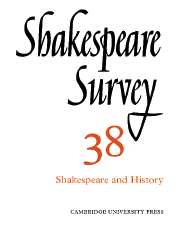Book contents
- Frontmatter
- Shakespeare’s History Plays: 1952–1983
- Shakespeare and History: Divergencies and Agreements
- Shakespeare’s Georgic Histories
- The Nature of Topicality in Love’s Labour’s Lost
- The Tragic Substructure of the Henry IV Plays
- Hal and the Regent
- The Rite of Violence in I Henry IV
- The Fortunes of Oldcastle
- Hand D in Sir Thomas More: An Essay in Misinterpretation
- Livy, Machiavelli, and Shakespeare’s Coriolanus
- Henry VIII and the Ideal England
- The Strangeness of a Dramatic Style: Rumour in Henry VIII
- ‘Edgar I Nothing Am’: Figurenposition in King Lear
- ‘Very like a whale’: Scepticism and Seeing in The Tempest
- Shakespeare’s Medical Imagination
- Shakespeare in the Theatrical Criticism of Henry Morley
- Shakespeare Performances in Stratford-upon-Avon and London 1983–4
- The Year's Contributions to Shakespearian Study 1 Critical Studies
- 2 Shakespeare’s Life, Times and Stage
- 3 Editions and Textual Studies
- Index
Shakespeare’s History Plays: 1952–1983
Published online by Cambridge University Press: 28 March 2007
- Frontmatter
- Shakespeare’s History Plays: 1952–1983
- Shakespeare and History: Divergencies and Agreements
- Shakespeare’s Georgic Histories
- The Nature of Topicality in Love’s Labour’s Lost
- The Tragic Substructure of the Henry IV Plays
- Hal and the Regent
- The Rite of Violence in I Henry IV
- The Fortunes of Oldcastle
- Hand D in Sir Thomas More: An Essay in Misinterpretation
- Livy, Machiavelli, and Shakespeare’s Coriolanus
- Henry VIII and the Ideal England
- The Strangeness of a Dramatic Style: Rumour in Henry VIII
- ‘Edgar I Nothing Am’: Figurenposition in King Lear
- ‘Very like a whale’: Scepticism and Seeing in The Tempest
- Shakespeare’s Medical Imagination
- Shakespeare in the Theatrical Criticism of Henry Morley
- Shakespeare Performances in Stratford-upon-Avon and London 1983–4
- The Year's Contributions to Shakespearian Study 1 Critical Studies
- 2 Shakespeare’s Life, Times and Stage
- 3 Editions and Textual Studies
- Index
Summary
When Harold Jenkins wrote his survey of criticism of the English history plays from 1900 to 1951 for Shakespeare Survey 6 (Cambridge, 1953) two critical approaches were dominant: firstly the reading of them in the light of the historical thesis which they were seen to present and which was particularly associated with E. M. W. Tillyard's Shakespeare's English History Plays (1944), and secondly close analysis of their style and imagery. It might be useful first to consider how these two modes of interpretation have developed in the period presently under review.
THE OVERALL PATTERN
The influence of Tillyard's thesis can be seen in the amount of reference to it in later work. Its attraction was that it provided the English histories with an intellectual dimension that they had previously lacked. Instead of being seen as immature and formless, perhaps the result of collaboration and revision by different hands, they were given the weight of a philosophical and political thesis. The interpretation of them in the light of the 'Tudor myth', reading English history from Richard II to Henry VIII as the working-out of a process of punishment and expiation for the deposition and murder of Richard II, God's judgement falling particularly on the house of Lancaster and more generally on the nation, provided the plays with coherence and dignity. An extract from a contemporary review of Tillyard's book illustrates in a small way how the thesis brought new significance to the plays: 'that dull old stick, Alexander Iden, becomes a steadying symbol of degree and of duty done in the allotted state of life'.
- Type
- Chapter
- Information
- Shakespeare Survey , pp. 1 - 18Publisher: Cambridge University PressPrint publication year: 1986

